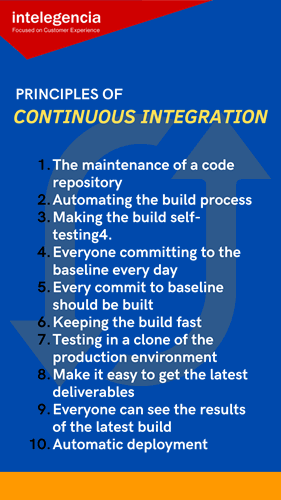Continuous Integration: Improving collaboration and developing better applications
 Fourth Lagao
January 6, 2021
Fourth Lagao
January 6, 2021
Creating a reliable and impressive software isn’t the work of one developer, but a whole team. When tech minds brainstorm, you can expect a result that goes beyond expectations.
However, like any other collaborative work, developing an application comes with a few bumps on the road. For one, it’s never easy to divide tasks and merge each part before deployment. Without continuous integration, compiling everyone’s parts can take up too much time and effort.
Defining continuous integration testing
Techopedia defines continuous integration as a practice where developers integrate their work regularly. Before it became the standard, teams typically took weeks to update their codes and merge individual bits. The downside of waiting too long resulted in a merge conflict, duplicated effort, and even stubborn bugs.
 Principles of Continuous Integration
Principles of Continuous Integration
What are the benefits of continuous integration?
Continuous integration is an excellent practice to implement across your IT departments for many reasons.
- Simpler and easier handling of code
Compared to integrating vast chunks of code, continuous delivery focuses on adding small bits and addressing fewer issues at a time. In doing so, developers can immediately find bugs in the code and apply fixes before it affects other parts of the application.
- Test reliability
Introducing features one by one makes continuous integration testing much more reliable and accurate. Developers can easily spot any issues or lapses because the improvements are more specific. Additionally, continuous integration makes room for more precise positive and negative tests.
- Reduced costs and boosted productivity
When developers focus on a code, it’s almost impossible to work on different projects. The demands of perfecting an application can take up the majority of the team’s time and energy. With continuous integration, developers get more time to spend on other projects because code changes are implemented quickly. Not to mention, the quality of the application and the code contributes significantly to increasing the ROI.
- Promotes accountability
Among the benefits of continuous integration is that it promotes accountability across the members of the team. Since each developer is assigned a part of the code (which is later on merged into one huge functioning file), it’s easier to point out who did what and who can fix which errors. It also makes way for rapid feedback.
- Improves Mean Time To Resolution (MTTR)
MTTR refers to how long the team can resolve or address issues in the code. It’s useful for tracking the amount of time that developers spend recovering from application failures or errors. Continuous integration improves this metric because the changes implemented in the code are smaller, and therefore risks are kept to a minimum.
- Keeps customers happy
There’s nothing more important than keeping your customers happy. Continuous integration can do just that. Deploy new features or quickly address bugs even before it dampens customer satisfaction. From first impressions to fast turnaround, this practice allows to improve applications and keep up with the trends. Feedback is almost immediately addressed, helping businesses foster customer loyalty while attracting new patrons.
Fourth Lagao is a Director of Business Excellence at Intelegencia. When he is not working, he Loves to do painting
Comment(s)
_BlogComment.Message
